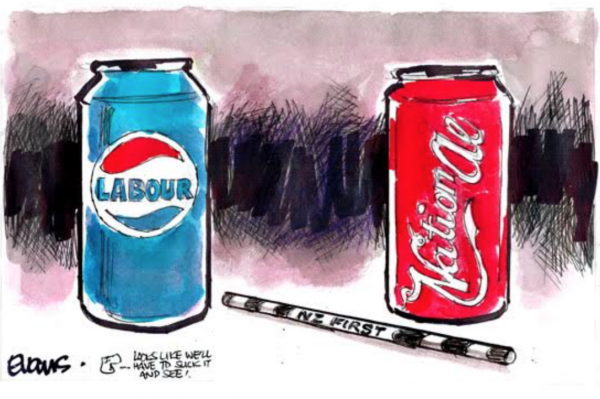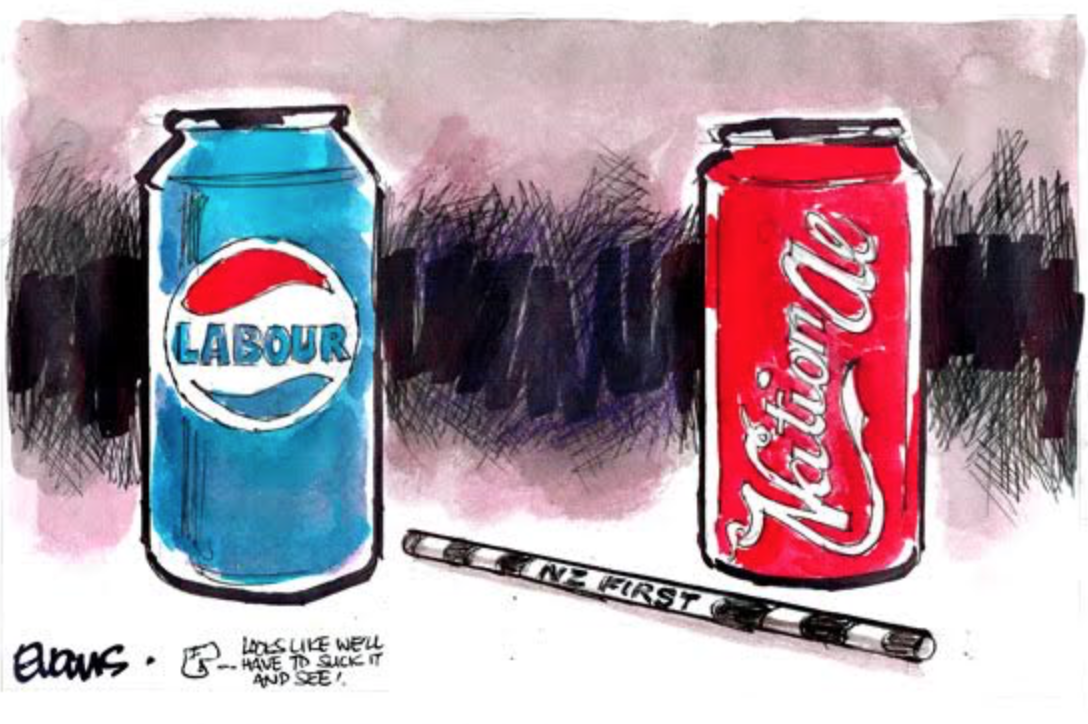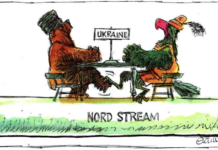
The election result was well predicted by the polls, Te Ururoa Flavell’s departure excepted. So, no surprises that Winston Peters is the power-broker this time. Also, no surprises that Peters has no competition for that role, given that New Zealand First is the only truly independent party in the 2017-20 Parliament. One surprise was the very high number of special votes; with Labour gaining 43 percent of the specials, and National only 36 percent. Indeed Labour fell short – by just a few votes – of gaining 47 seats; that would have made it National 55, Labour-Green 55.
The other big surprise should have been how few votes were cast in Auckland, and how many were cast in the hinterland. So far, I’m the only one to have noticed: see my Auckland Population: Evidence from the Election. As reflected in much anecdotal evidence, Auckland is shrinking relative to the rest of the country. Statistics New Zealand estimates of Auckland’s population “increasing by 50,000 a year” are based on extrapolating 2006-13 growth trends. Easily the lowest number of votes cast in 2017 were in Tāmaki-Makaurau. Auckland Central also had a very low vote count, despite 8,400 specials (28% of all votes in that electorate). Auckland may even lose an electorate when the boundaries are redrawn after the 2018 census. Auckland’s demography has changed since 2013.
Following my pre-election reflection, Chris Trotter suggested that I my misguided view was “guided by the historical precedent of the 1969 “nearly-but-not-quite” election. Yes, in part my view was; I remember the 1969 election well. Certainly in 1972, the New Zealand electorate was better prepared for innovative change. In 1969, the still-conservative electorate had been freaked by the demonstrative disruptions to Keith Holyoake’s campaign, by a Progressive Youth Movement led visibly and audibly by Tim Shadbolt. Indeed, in 1969, to win its fourth term, National in government won two seats from opposition parties (a rare event in those days): Wanganui (as it was then), a seat Labour had taken for granted; and Hobson from Social Credit. (Chris Trotter reminded me of the 1969 Bob Chapman and Keith Sinclair election story. In 1942 my father served with Chapman and Sinclair in a gun-emplacement at the end of Whangaparaoa Peninsular; I was named after Keith Sinclair.) 1969 was a recovery year; wages started growing substantially, after a decade of general wage orders that did not allow for productivity gains. Also the moon-landings had been a marvellous distraction.
1969 was also the first election in which South Island electorate quota was adopted, meaning an increase in the size of parliament after each subsequent census (until MMP refixed parliament at 120 seats). Under the FPP version of the formula (ie had we retained FPP in 1993, we would have had over 120 MPs in 2020. (On that matter, by the end of this century, we will revert to FPP unless in future the South Island population grows as fast as the North Island population.)
I disagree with Chris Trotter about Labour’s relationship between 1935 and 1938. Sure, the 1935 Labour vote was well short of 50%. Indeed 10% of the vote went to Independents that year. Labour also had Ratana and Country Party support. What really made it (mathematically) for Labour was the spoiling effect of the new and short-lived far-right Democratic Party, which took eight percent of the vote. What really clinched it for Labour was its promise, on the hustings, to introduce universal and largely unconditional social benefits. Here we must appreciate that the cruel bureaucracy which surrounded entitlement to benefits in the depression years was not unlike the bureaucratic apparatus that is creating a mental health epidemic today; the very real problem that the Green Party tried to start a conversation about this election.
For much of the time, Labour in 1936 and 1937 tried to backslide on its electoral promise. The left of Labour wanted to focus on redistribution through raising conditional benefits. The right of Labour looked to create an early version of Roger Douglas’ 1974 actuarial superannuation scheme. With the help of some public servants, and with the coming election in mind, Savage rejected both of these, and resurrected the universal scheme from the bottom drawer. It was an extraordinary vote-winner. And, as Elizabeth Hanson pointed out in 1980, it came in well under budget.
This was Labour coming into the 20th century, creating a comprehensive social support system, and not just extending the ‘selective’ class-based welfare that developed in Australasia in the 1890s. That system still forms the philosophical basis for Australian social welfare; refer to Frank Castles’ 1985 thesis: The Working Class and Welfare. The other part (in 1936) of Labour’s entering the 20th century was the use of new monetary policies – specifically Reserve Bank credit – to enable the state-housing scheme that not only housed New Zealanders but also created the multiplier effects that got New Zealand back to full employment by 1939. (Chris Trotter’s Adults in the Room? is a particularly worrying exposition of how much courage and mental catch-up Labour still requires.)
Labour in 2020 needs to adopt 21st century macroeconomic management philosophies. In other parts of the world these began after the global financial crisis, with fiscal stimuli and quantitative easing. Not in New Zealand, however. New Zealand will need to adopt 21st century monetary policies at some time in the next decade. And Japan has shown the world how public debt can be a 21st century solution to late-twentieth century public investment shortfalls and private miserliness.
The world in the twenty-first century can address its inequality problems only through the adoption of public equity solutions. Otherwise the latter part of the century can only become as dystopic as so much of today’s contemporary popular fiction suggests. This conclusion is formed by the remorseless arithmetic of increasing inequality; it is not formed by an anti-rich ideology.
On this last matter of public equity, Labour can start by either adopting the simplified tax scale I have suggested or by embracing and reconceptualising the misnamed Family Incomes package legislated from the 2017 Budget. (It’s misnamed because it provides benefits for individuals as well as to families.) Labour says it is ‘tax cuts for the rich’. But it’s not really so. National’s legislation neither reduces the top tax marginal rate nor raises the threshold for which that rate becomes effective.
The 2017 Budget creates and extends what can alternatively be called a Public Equity Benefit (in this case, upto $195 per week). A simple reconceptualisation converts a ‘tax cut’ into a ‘benefit increase’. That reconceptualisation – embracing ‘public equity’ as a means of distributing capital income (social profit) to the masses – takes us into 21st century thinking. (The cheaper alternative creates an unconditional Public Equity Benefit of $175 per week.) In both cases, we have an unconditional though not universal benefit, created at zero cost from a tax-benefit-accounting framework that is relevant to present times. Of particular importance, changing the way we account for income taxes and benefits today creates the means to equalise (and raise) equity benefits in the future. It’s simple, it’s necessary, and it’s twenty-first century thinking.
Let’s make the next decade about solutions, not about problems. Let’s apply more new thinking to what we are for, less to what we are against. It doesn’t matter who is Prime Minister. We can have a twenty-first century multi-party democracy, through which all good ideas can be placed on the table, and considered on their merits.






The Wage Slave Labour Party needs to tear up the Free Slave Agreement with the rapacious, organ-harvesting Chinese dictatorship.
At least Winston will keep them honest.
In a 21st century democracy, would the negotiations currently being carried include all parties at the table and be open to the media and public?
It would be most instructive to find out what the real bottom lines are and what are more rubbery form all parties.
Seems more than a trifle odd that perhaps the most important discussions that impact on us all at present are held behind closed doors.
During the Election Bill English was talking about workers an extra getting $1000 a year from tax cuts. What we didn’t mention is that’s only for those earning just above the median income. The working poor and those surviving on benefits would get a fraction of that. Those in the top 10% get much more. Of course it’s tax cuts for the rich, and I’m mystified by this claim that it isn’t.
If they were cutting GST by a similar rate instead of income tax, that might be a bit different. But the same public money could be put into raising benefits towards a livable level, or dropping the cost of doctors visits, or buying back residential property for social housing, or any one of hundreds of other policies that would move that money to where it’s needed.
No one can resign from the Chinese Communist Party, you are either expelled or given a lead injection. Not a bad piece in the Herald today by Bryan Gould. Very measured words, so as to fly under the radar. It will be interesting to see if any responses are printed in the Letters section as a result, apart from the usual poison directed at Gould whenever he says anything that infuriates the RWNJs.
“Labour in 2020 needs to adopt 21st century macroeconomic management philosophies. In other parts of the world these began after the global financial crisis, with fiscal stimuli and quantitative easing. Not in New Zealand, however. New Zealand will need to adopt 21st century monetary policies at some time in the next decade. And Japan has shown the world how public debt can be a 21st century solution to late-twentieth century public investment shortfalls and private miserliness.”
Yes yes and yes. I am trying my best to convince progressive friends of this but they just can’t get passed the “public debt is the devil” frame.
Mr Rankin – please talk more about this! It needs to be explained to NZ audience better.
Too much public debt and the money markets get nervous and raise interest rates. It also will mean less credit available for private investment, though with most investment going into the housing market these days that may not be a bad thing.
This is the classic retort against MMT ideas – bond vigilantes and crowding out as constraints. First deficit spending doesn’t need bond issuance – but if you do do it, it is some private saving assets for someone. Deficit spending without bond issuances increases money supply and lowers interest rates (increased reserves) – how can it crowd out private investment by raising interest rates when it puts reserves into the system? Private investment is determined by the animal spirits of the banks not government spending. Second, we are not Greece. We own our currency. We aren’t in the Euro where we could default. We are like the US and Japan. US and Japan have huge deficits and public debt far in excess of ours. But yields are very low. Finally, what is the point in running the country into the ground with austerity and keeping people in misery just because we might need to pay a bit extra on a 10 year government bond that we can print the money to pay anyway? Better to spend a bit, rejuvinate our economy, issue bonds if you must and let economic growth take care of the interest payments. In the long run we are all dead.
Funny you should say that CS cause when the Greens said we should print some money they got laughed out of parliament and those laughing the loudest was those selfish tory pricks
The Greens were right about it in my opinion – Japan is doing it via direct central bank financing of deficits and the US is doing it stealthily via QE – correct me if I’m wrong I think I heard this from Adair Turner formerly of Bank of England – (Fed printing money buying up all the old treasury bonds and then the treasury issuing new bonds to “fund” its deficit with all the “printed money” sloshing around from the QE). Do you see any mass stampede of spooked investors running away from the US or Japan? Yes China could give up buying US treasuries with its US $ – but then it wouldn’t have an export market would it? Self-defeating. Everyone still has an irrational fear of inflation in NZ and a belief that you can’t have full employment without hyperinflation. Stagnant wages and deflation are the real problem – making our debt burden overwhelming. The oil shocks were in the 1970s people. Time to move on.
As the world changes with all manner of trade agreements made before this point and the (TPPA having over our heads -no thanks to national) – we now see that the changes made are now more difficult than before, so we should not be surprised at the delays should we not?
Comments are closed.